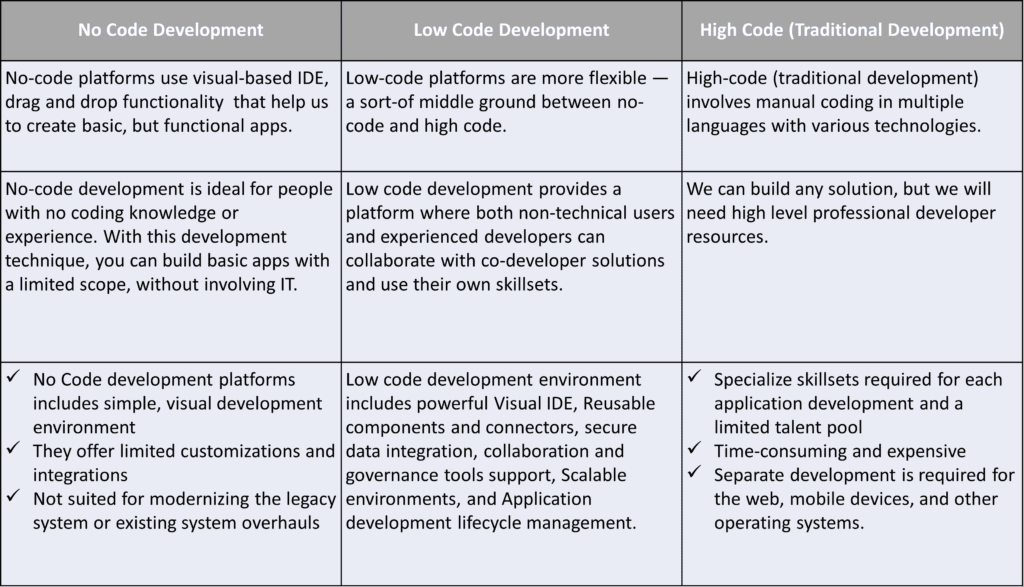Low-code application development platforms come in different flavors. It ranges from enterprise-grade low-code for IT professionals to deliver and enhance complex business solutions, to lightweight low-code for use by citizen developers to create simple application extensions. LANSA fits in the first category. In their own way, both low-code categories can reduce the time it takes to deliver business solutions. In this way, software development teams can deliver business apps more quickly, and business users (citizen developers) can participate in the application development process. Low code uses a model-driven, drag-and-drop interface rather than a technical coding environment. Low code allows developers of all experience levels to create value-driven corporate business applications, including professionals, novices, subject matter experts, business stakeholders, and decision-makers. You can explore more on Low Code Solutions in this post.
What Is Low-Code?
Low-code platforms allow business users and IT professionals to create business applications using graphical user interfaces instead of traditional coding. In low code solutions, coding is replaced by building apps visually by dragging and dropping UI components.
Using low-code application platforms, all of the project’s components, such as frontend, backend code, and configuration files, are automatically generated based on standard best practices. Here, you can see the details about what is as400.
What Are The Features And Benefits Of Low-Code Platforms?
Low-code platforms have several benefits and features that are listed:
Visual Modeling
Low code development platforms consist of separate Visual IDE (Integrated Development Environment) and visual modeling tools for app development. Low code platform includes drag and drop interface for progressive web app builder and visual UI (user interface) features that not only reduce the development time but also increase the software developer’s productivity.
Reusable Components
Low-code platforms allow tech and business professionals to build cross-platform applications with pre-configured modules, connectors, logic, templates, and data models. Skill developers can extend and customize the components of low-code apps and automate processes.
Collaboration Tools
Collaboratively work with built-in tools for feedback loops, messaging, revision tracking, user stories, and more. The visual development of low-code software solutions keeps the development language understandable and the same for everyone.
Scalable Environments
Allow to build mobile apps and modernize the existing applications as the business needs change. The new cloud-based low-code environment supports continuous application delivery. Moreover, it provides more flexibility and support for run-time scalability on demand.
Integration And APIs
A low code development platform allows us to securely integrate the data and logic from any core legacy system or service. In addition, professional developers can integrate custom code or build apps using pre-configured APIs and connectors.
Artificial intelligence
Improve the client experience by utilizing built-in AI features like classification, scoring, next best offer (NBO), and next best action (NBA) recommendations.
Governance Tools
The right low-code governance tools will fuel the digital transformation process. We can create user roles, set up application approval processes, manage application access privileges, and use built-in application and infrastructure monitoring tools.
Security
Build secure apps while adhering to industry standards. Built-in security tools provide visibility and insights into all platform activities.
Application Lifestyle Management
Low-code supports application lifecycle management with tools to streamline business process management, version control, requirements management, automated testing, deployment, and more.
Learn more about the benefits of low-code development.
What Are Low-Code Use Cases?
Different use cases available for low-code platforms are given:
Customer Engagement Applications
Build native mobile applications to efficiently address a wide range of customer issues and solve business problems.
Employee Experience And Corporate Services
Streamlines daily business processes including, employee request management and control audit as well as provides internal service and customer support.
Operational Efficiency Applications
Build applications to automate manual enterprise-grade operational processes for a variety of business domains. Replace the manual processes with intelligent and automated workflows that reduce cost and improve the efficiency and cross-departmental alignment
Legacy Modernization
Integrate modern technologies with existing applications to modernize or extend legacy systems to meet growing business needs. See details about what legacy modernization means.
Collaboration and Coordination Apps
Develop applications that enable you to interact, collaborate, exchange content, plan activities, and manage reviews as quickly and easily as possible.
Vertical-focused Automation
Build progressive web apps to streamline operational business and customer-facing processes that are specific to your business domain.
What Are Low-Code Industry Solutions?
Low-code/no-code environment suitable for different industry solutions which are listed:
Banking
Low code tools streamline business banking tasks and enable front and middle office specialists to collaborate and participate in digital transformation activities.
Manufacturing
Low code/no code development platforms offer highly adaptable digital solutions for managing production, manufacturing processes, warehousing, and LOB operations.
Logistic And Transportation
low code/no code platforms typically streamline the end-to-end supply chain operations. Moreover, low-code technology enables your staff to optimize their daily workflows and build new business applications rapidly.
Telecom
Low-code/no-code tools help in rapid application development and automate the different operations of telecom infrastructure management.
High Tech
Boost the professional developer’s productivity by allowing them to use the low-code components. In this way, they can spend more time on custom app development.
Business Services
Create customer-first organization in which low code platforms automate the business services and improve the personalized customer experience.
Why Do We Need A Low-code Platform?
Development teams are under pressure as a result of rising customer expectations and the rapid digital transformation of recent years. They are expected to deliver much more complex software applications in ever-shorter timespans while also maintaining, managing, and evolving the existing app portfolio.
Companies are also facing difficulty in recruiting new coding skills developers because there aren’t enough engineers to meet current development demands. In this situation, the use of low code platforms is so popular. Low code development tools empower your employees to workflow automation that boosts developer productivity and faster the digital transformation process.
Low code solutions enable businesses to create apps that not only enhance the customer experience but also bring data and insights together to ensure customer data privacy. Moreover, low code tools reduce the total cost of ownership. They also help in governance and risk management.
Low-code vs. No-code vs. High-code: What Are The Differences?
Low code platform provides a development environment where both non-technical users and professional developers can interact or collaborate with co-developer solutions and use their own skill sets.
Who Can Build With Low-code?
Anyone can use a low-code platform to address today’s business challenges by using separate integrated development environments (IDEs). The Low-code platform is intended for both professional and business developers. The low code users are professional developers who work in enterprise IT departments. Others, business users (citizen developers) with little to no coding experience can create simple productivity apps using low code.
Every low-code platform is the same. The major distinction we must understand is the low-code providers they target. We must write a specific amount of code to accomplish complex features. Furthermore, the low code development approach enables subject matter experts, business analysts, process owners, and company owners can all become application developers.
What Are The Best Low-Code Development Platforms?
There are several low-code development platforms available on the market. We have enlisted the code development platforms that are currently popular in 2023.
- Visual Lansa
- Mendix
- Salesforce
- Oursystems
- Retool
- Microsoft Power Apps
- Quixy
- Creatio
- GeneXus
- Strikingly
- Appian
- UI Bakery
How To Pick A Low-code Platform?
When we pick a low code development platform for modernizing the IBM i series versions or for software development, our platform should have the following features:
- Separate collaborative IDEs
- Easy data integration
- Application development lifecycle
- Agile application development support
- Boost business user’s and professional developer’s productivity
- Good support for user experience
- Cloud support
What Is The Future Of Low-Code?
Low-code development is the future of software application development. Low-code platforms can reduce development time by 90% as compared to traditional application development. According to recent research, it is predicted that by 2025, 70% of apps will be built using no-code/low-code technology. So, businesses rapidly embracing low-code strategies for their business applications.
Are You Ready To Choose The Best Low-Code Development Platform For IBM i Application Development?
Visual LANSA is one of the best low code IBM i development platforms. It allows businesses to modernize their legacy systems according to growing business needs. Businesses may create new enterprise-level graph visualization web applications rapidly such as mobile applications, web, and desktop applications with LANSA. In addition, using low code/no code technologies modernize the legacy IBM i green screen apps into more attractive web and mobile applications.











